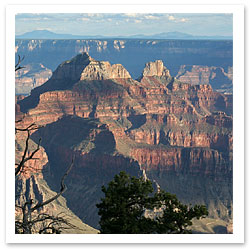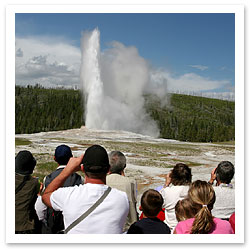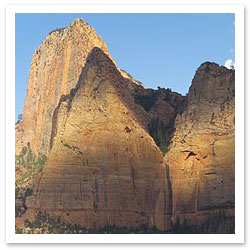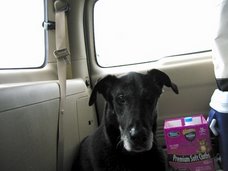 The ongoing Family Road Trippers geographical scavenger hunt!
The ongoing Family Road Trippers geographical scavenger hunt!
Find this ruin somewhere in the deep south, either Alabama, Mississippi, or Louisiana. A little off the beaten path, but near the alma matter of "Air McNair".
As always, if you can identify this place, we'll send you a free barf bag!
(Please don't play too closely to the columns -- they may fall over)
Find This Place! Deep South
7 Mistakes Not to Make When Dining Out with Kids
If a restaurant dispenses tiny packets of crayons enrobed in whimsical paper placemats, you've likely discovered a place that considers itself kid friendly. But is it a place you want to go? Deep in your heart you know it isn't. And wherever you travel, you're probably finding that the desirable places to eat aren't necessarily clear about whether they're kid friendly. Ultimately, though, showing your kids a good time isn't the restaurant's job -- it's yours. And believe it or not, you can do more than just survive a night out with your kids if you avoid these common blunders.
Mistake #1: Picking a place devoid of other kids
While you're away, pick restaurants based in part on who else is eating there. Look for at least one other family with kids close in age to your own. If the crowd feels cold when you get there, walk. Unless your child's perfectly still and silent (aka unconscious), she'll likely want to go say hello to the other family. One of the easiest things to forget while on vacation is how much your kids miss their friends back home, and watching your daughter and her new friend chatter about tween stars or annoy the fish in the tank up front will remind you how those instant restaurant friendships can create your child's fondest memories of a trip.
Mistake #2: Relying on the kids' menu
A kids' menu is often unimaginative and overpriced and what's worse, its dishes often have no relationship to the good food on your menu. For a better meal, have the waiter halve one of the adult entrees or, better yet, order your child not one but several appetizers. This eliminates the drama of your child saying she doesn't like the taste or smell of her entrée, increases the chances of her hitting upon something she likes, and opens her eyes to new flavors and combinations. The meal will be more satisfying and, potentially, less pricey.
Mistake #3: Trying a totally new food on vacation
While it's tempting to introduce your kids to that regional dish you've been craving, don't be recklessly experimental. For instance, shellfish -- so simple and ubiquitous in New England, the Caribbean, and countless other family destinations, is a good candidate for an allergic reaction if your child has never tried it. If shellfish or some other ingredient is an unknown or a problem, also be mindful of more subtle manifestations. If your waiter's unclear if the fish chowder is prepared with shellfish or if the kitchen fries the shrimp and clams separately from the french fries, insist he ask the chef. An allergic reaction may be limited to a single bout of vomiting, but do you really want your child's defining memory of the trip to be, "Remember when I threw up?"
Mistake #4: Not anticipating meltdowns
Trying to arrest a child's meltdown as it's happening is a lot like taking sea-sickness pills at the first sign of nausea: nice idea, but you're about an hour too late. By no means beat yourself up for letting the day get away from you at that world-famous zoo or great-for-kids beach. But if you go this route, don't mar a perfect day by expecting dinner to unfold calmly: anticipate that your kids might be starving or exhausted and know their time limits, especially if you insist on making every restaurant meal count -- and it can. Just eat strategically. Since appetizers, theoretically, are supposed to be ready quickly, ordering several for all of you in lieu of entrees might be the best plan. And did you ever wonder why you see so many parents drinking coffee with their meals? It's not just to shake off insanity; they already know they won't be around to enjoy it later.
Mistake #5: Having their meals brought out first
Assuming your kids aren't starving or exhausted, don't have their dishes come out before yours. Many waiters will assume that you want the meals staggered and may not even ask your consent; be clear. If your kids dig in before you they'll either be done or bored by the time your food arrives. Coloring books or handheld gaming devices may fill some of the time, but soon the relentless whining about why they shouldn't have to watch you eat will begin to make sense, you'll start to rush, and it'll be your fault. You've earned the right to try your destination's best food without indigestion, and even if having your family eat together at home is torture, they may surprise you and rise to the challenge while dining out. Especially if they ever hope to see that dessert tray arrive at your table.
Mistake #6: Not tasting their food first
This one may seem alarmist. I know I thought it was, at least until a trip to an elegant San Francisco restaurant, where my then four-year-old daughter bit into her kids' meal and began tearing up and fanning her mouth. It seems the chef had mistakenly given her the same red pepper flake-laced meatballs he was serving to adults via the grown-up menu. This was a mistake on the part of the kitchen (they had meant to serve her from a milder batch). Regardless of how mild or uninteresting their food may look, vet it for weird spices, off-tastes, and extreme temperatures, at least until they're ready to leave for college.
Mistake #7: Being a jerk when things go wrong
In the near future a restaurant is going to disappoint you. It might involve a waiter forgetting to put somebody's order in, passing a steaming hot cup of coffee over the head of your infant son, splashing sauce on your sleeve, or exhibiting some other lapse in service, judgment, or coordination. When it happens, take a deep breath and think about what you're going to say. Good restaurants want to make amends for their mistakes (hot pepper girl got a free sundae), and freaking out will only mortify your kids and make the rest of the meal uncomfortable. If your grandstanding is meant to prove to your kids that you're not a pushover, great, we all get it, but consider a more measured approach that sets a good example and doesn't amount to dinner theater for the rest of us. A quiet but firm attitude may not feel as good as outrage, but it might get you more satisfaction in the end. And your kids just may respect you for it.
---Paul Eisenberg
Paul Eisenberg, a Fodor's editorial director and father of three, has overpaid for kids menu meals, failed to anticipate many a meltdown, and given up on the possibility of sipping coffee after dinner. He previously wrote about mistakes to avoid on family road trips.
Photo credits: © Istockphoto/ Jason Lugo
Avoiding the Masses at 4 Great National Parks
This is fresh off the Fodor's Travel Wire: What could be better than a summer vacation spent communing with nature in one of our national parks? Unfortunately millions of others will be doing the same thing. But that doesn't mean your holiday has to be spent dodging video cameras and screeching kids. Follow our tips below to escape the hordes and make the most of your time in the park.
What could be better than a summer vacation spent communing with nature in one of our national parks? Unfortunately millions of others will be doing the same thing. But that doesn't mean your holiday has to be spent dodging video cameras and screeching kids. Follow our tips below to escape the hordes and make the most of your time in the park.
Grand Canyon National Park
If you're visiting the Grand Canyon in summer, avoid highways AZ 64 and U.S. 180 from Flagstaff like the plague. Take U.S. 89 north from Flagstaff instead, and pick up U.S. 64 to the west, which brings you to the Canyon's South Rim. Arrive well before 9 a.m. or after 4 p.m. to avoid the insane lines. Or head to the North Rim where the views are even prettier. The North Rim only gets about 10% of the number of visitors as the South Rim. Why? Because getting there tacks another 215 miles onto your drive from Flagstaff (take U.S. 89 north past Cameron, left onto U.S. 89A at Bitter Springs to Jacob Lake and then AZ 67.) It's a super scenic drive and well worth the effort to avoid the hordes at the South Rim.
When to Visit: The busiest times to visit Grand Canyon National Park are summer and spring. Visiting during these times will mean negotiating crowds. Be patient. Remember that you cannot visit the North Rim in winter due to weather conditions.
The Ranger's Tip: Navigating GCNP is a big task, one made easier by the free shuttle system, says Chuck Wahler, a 16-year employee of the park. Buses stop at 30-some points of interest, and Wahler advocates hopping aboard whenever possible. "You'll spend more time exploring the park and less time looking for a place to park."

Yellowstone National Park
To avoid crowds at Yellowstone, get into the park at or just before sunrise if possible, before 9 a.m. for sure. See Old Faithful erupt during the earliest hours (the geyser spews about every 70 minutes, visitor centers have lists of the anticipated times) and check out the very popular Mammoth Hot Springs and the Norris Geyser Basin either early in the morning or late in the day. Then head to less populated parts of the park -- such as the Lone Star Geyser, Point Sublime, Fairy Falls, and Yellowstone Lake -- between 10-3 when the crowds start building. Don't miss a swim in the Gardner River, two miles north of Mammoth on the North Entrance road. Here, you can paddle about in a warm river fed by the park's hot springs.
When to Visit: You'll find the big crowds from mid-July to mid-August. There are fewer people here the month or two before and after this peak season, though you'll also find fewer dining and lodging facilities open. Most of the park closes from October to mid-December and again from March to late April or early May.
The Ranger's Tip: Park Ranger Mary Wilson recommends packing for all types of weather no matter what time of year it is, remaining at least 75 feet away from wildlife (300 feet for bears), and staying on geyser basin boardwalks to prevent serious thermal burns.
Yosemite National Park
To beat the crowds to Yosemite you've got to get up before sunrise and into the park before dawn. Yosemite has four entrances, and traffic moves about as quickly (or sometimes just as slowly) through all of them. Once you're in the park, head to wildly popular Yosemite Falls for a spectacular sunrise, then escape to Tuolumne Meadows (on the east side of the park) to explore its many hiking trails and have a picnic lunch. Or head to Hetch Hetchy Valley, 40 miles from Yosemite Valley, to enjoy a quiet afternoon amid spectacular scenery and waterfalls.
When to Visit: Mid-April through Memorial Day and from mid-September through October are good times. During extremely busy periods -- like the 4th of July -- you may experience delays at the entrance gates. If you can only go during the warmest months, try to visit midweek.
The Ranger's Tip: Park Ranger Scott Gediman loves to hike Yosemite's trails. His favorite is the Mist Trail to Vernal Falls. "I've done it literally hundreds of times. If you can only take one hike in Yosemite, do this one, especially in spring and summer."

Zion National Park
Zion is the most heavily visited national park in Utah, and most of its guests arrive through the South Gate. To avoid the bottlenecks, take Utah 9 to the east entrance. You can see all the highlights of the park on the Zion Canyon Scenic Drive shuttle ride, but go as early in the morning as possible. Once the crowds pick up, most of them will be milling around Zion Canyon. If you're in the mood for a little adventure, get off at the shuttle's last stop (Temple of Sinawava) for a riverside walk to The Narrows, one of the prettiest parts of the park. The first mile of the walk, between cliffs and alongside the Virgin River, is easy and wheelchair accessible. If you want to continue on, the going gets rougher -- be prepared to walk through water that is occasionally a few feet deep on some parts of the trail. For a great short easy hike, wander up to Weeping Rock, a cool damp alcove that's often filled with wildflowers. Or take the 10-mile-round trip Kolob Canyons Scenic Drive to check out the colorful sandstone cliffs and deep gorges.
When to Visit: Between April and October, Zion is visited by a staggering 2.5. million people. Winters are mild at lower elevations here, so consider planning your visit for some time other than peak season. You can expect winter driving conditions November through March, and though many park programs are suspended at this time, winter is a wonderful and solitary time to see the canyons.
The Ranger's Tip: "Menu Falls, hidden in a lush and tranquil ravine along the Virgin River, is a little-known waterfall bypassed by thousands of visitors each day," says Ron Terry, Chief of Visitor Services at Zion National Park. "It got its name because a picture of it was on the original Zion Lodge menu. The falls are about a half-mile walk north of the Big Bend shuttle stop."
National Parks Basics
Your first stop in the park should be the visitors center, where you can get up-to-the minute information on park conditions and purchase permits if you'll be hiking in the backcountry or camping.
See the Fodor's National Parks page for more helpful advice on visiting the national parks of the west.
--Michelle Delio
Wacky Summer Festivals in America
America is full of festivals, contests, and competitions. Some are earnest, others completely wacky. Here are 12 that register high on our Outlandish Meter.
(Edited from Fodor’s wire) International Cherry Pit Spitting Contest
International Cherry Pit Spitting Contest
When: July 7
Where: Eau Claire, in Southwest Michigan
How many times did your mother tell you not to play with your food? Well now you can show her who's boss when you bring home the trophy for the 34th annual Cherry Pit Spitting Contest. Qualifying Rounds start at 10 a.m. and the championships start at 1 p.m. If you're not into spitting, you can pick cherries, eat cherries, and celebrate all things cherry. www.treemendus-fruit.com/int.htm
Milk Carton Derby
When: July 7
Where: Southwest Corner of Seattle's Green Lake
More than 100 sea-faring vessels constructed of 50 half-gallon cartons take to the lake for this annual event. If you can't get your sea legs, there are numerous activities on shore to entertain. There's also the Canine Fashion Show. www.seafair.com
Talkeetna Moose Dropping Festival
When: July 14--15
Where: Talkeetna, Alaska
There are lots of events in this annual fundraiser, although no animals are dropped, despite the name. The festival does call for the handling, however, of some unpleasant animal byproducts. For instance, there's the Moose Drop Dropping Raffle and the Moose Poop Toss Game. There's also the Mountain Mother Contest on Sunday that highlights the strength and endurance of Alaskan Moms, who must compete in a variety of activities with a "baby" strapped to their backs. www.talkeetnahistoricalsociety.org/
Where: Pittsfield, Maine
For 35 years this New England town has been celebrating the incredible, edible egg -- brown eggs to be exact. This year's theme is "Staying Egg-Alive." There's an early-bird breakfast, which uses the world's largest frying pan, the "Egglympics," a chicken barbecue, and a whole lot more egg-tastic fun. http://eggfest.craftah.com/
Great Texas Mosquito Festival When: July 26--28 Where: Clute Municipal Park, Clute, Texas
Where: Clute Municipal Park, Clute, Texas
In addition to the world's largest mosquito -- a 26 ft. Texas mosquito complete with a cowboy hat, boots, gigantic wings and a big stinger -- there's a mosquito-calling contest, a dodge-ball sting tournament, and a contest for the best-looking Mosquito legs. Who will be crowned this year's Mr. or Ms. Mosquito Legs? You'll just have to buzz on by to find out. Don't forget your bug spray. http://mosquitofestival.com
Tug Fest When: August 9--11
Where: LeClaire, Iowa and Port Byron, Illinois
For 20 years, the town of LeClaire has taken on its rival across the river, Port Byron, in the annual Tug Fest. A 2,400-foot rope weighing 680 pounds is stretched across the Mississippi River and teams on either side of the river tug away for bragging rights. This year the tug takes place on Saturday, August 11 at 1 p.m.. The contest also includes live music, rides, and foods. As it stands, the score is Iowa 10, Illinois 9. Who will rule the river this year? www.tugfest.com; www.tugfest.org
---Alexis C. Kelly
Fodor's editors Maria Burwell, Sarah Cullen, Maggie Kelly, Heidi Johansen, and Adam Taplin contributed to this report
Do you know of any WackyFests? Let us know!
Find This Place! New England
 The Family Road Trippers Scavenger Hunt! (Part 1)
The Family Road Trippers Scavenger Hunt! (Part 1)
This cattle pen is somewhere in New England. It was build in 1828 for $28.
The granite river rock walls are seven feet tall and 2-1/2 feet thick at the base. The circumference is 40 feet.
If you can find this place, email us a photo o0f your family standing in front of it and we'll mail you an official Family Road Tripper Barf Bag!




